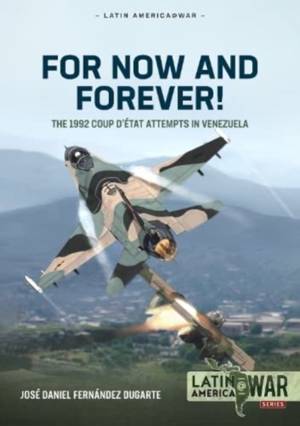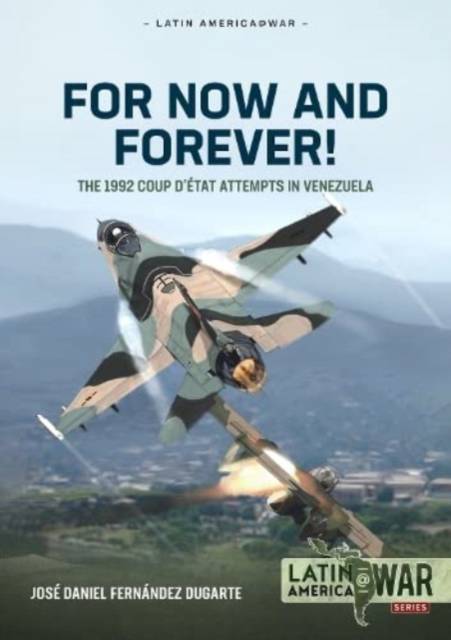
- Retrait gratuit dans votre magasin Club
- 7.000.000 titres dans notre catalogue
- Payer en toute sécurité
- Toujours un magasin près de chez vous
- Retrait gratuit dans votre magasin Club
- 7.000.0000 titres dans notre catalogue
- Payer en toute sécurité
- Toujours un magasin près de chez vous
For Now and Forever!
The 1992 Coup d'État Attempts in Venezuela - Volume 1: Causes and the Opening Moves of the February 1992 Coup
José Daniel Fernández Dugarte
27,95 €
+ 55 points
Description
"This particular volume provides a background to Venezuela's political past and the multiple events that led up to the 1992 insurrection. It is obvious during the reading of this book that the author has done his research. Not only that, but he does a superb job of telling the story and keeping the reader engaged." -ModelingMadness.Com
Rich in oil, Venezuela should have been one of the wealthiest nations in Latin America, if not the world, yet in the 1980s its economy collapsed plunging many of its citizens into poverty. In 1992 elements of the armed forces of Venezuela twice attempted to overthrow the nation's government. These coup attempts saw the army, navy and air force fighting one another and the other security forces on the streets and in skies of Venezuela in what would ultimately prove, in 1992 at least, to be futile attempts at revolution. For Now and Forever! examines these 1992 coup attempts.
Like many South American countries, Venezuela has had something of a tumultuous history, the modern independent state being born in 1830 following a series of revolutions and wars against Spain and breaking away from Gran Columbia, with further civil wars and confrontation with European powers continuing into the early twentieth century. Politically, the country veered between various forms of democracy and dictatorship marred by occasional violence. A left-wing revolutionary guerilla movement in the 1960s failed to gain popular support and was ruthlessly suppressed.
Oil was discovered in Venezuela in the early twentieth century and for a while brought prosperity to the country. Following the Middle East war and crisis of 1973 oil prices soared and Venezuela borrowed heavily on this basis; when in the 1980s oil prices crashed, so did Venezuela's economy. Growing discontent led to the Caracazo riots in 1989 that were brutally put down by the security forces leaving hundreds of protesters dead.
Many junior officers in the military had long sought reform and revolution. Cultivated by future president Hugo Chávez and the MBR-200 (Bolivarian Revolutionary Movement-200), the events of 1989 provided a spark to action that would lead to two attempts to conduct military coups in 1992 to overthrow President Carlos Andrés Pérez Rodríguez.
For Now and Forever! provides a detailed two-volume military history of the 1992 coup attempts. The first volume examines the history, organisation and equipment of Venezuela's armed forces, the political background and causes of discontent within the country, the 1989 Caracazo riots, and the early stages of the first coup attempt in February 1992. This volume is richly illustrated throughout with original photographs and includes specially commissioned artworks and maps.
Rich in oil, Venezuela should have been one of the wealthiest nations in Latin America, if not the world, yet in the 1980s its economy collapsed plunging many of its citizens into poverty. In 1992 elements of the armed forces of Venezuela twice attempted to overthrow the nation's government. These coup attempts saw the army, navy and air force fighting one another and the other security forces on the streets and in skies of Venezuela in what would ultimately prove, in 1992 at least, to be futile attempts at revolution. For Now and Forever! examines these 1992 coup attempts.
Like many South American countries, Venezuela has had something of a tumultuous history, the modern independent state being born in 1830 following a series of revolutions and wars against Spain and breaking away from Gran Columbia, with further civil wars and confrontation with European powers continuing into the early twentieth century. Politically, the country veered between various forms of democracy and dictatorship marred by occasional violence. A left-wing revolutionary guerilla movement in the 1960s failed to gain popular support and was ruthlessly suppressed.
Oil was discovered in Venezuela in the early twentieth century and for a while brought prosperity to the country. Following the Middle East war and crisis of 1973 oil prices soared and Venezuela borrowed heavily on this basis; when in the 1980s oil prices crashed, so did Venezuela's economy. Growing discontent led to the Caracazo riots in 1989 that were brutally put down by the security forces leaving hundreds of protesters dead.
Many junior officers in the military had long sought reform and revolution. Cultivated by future president Hugo Chávez and the MBR-200 (Bolivarian Revolutionary Movement-200), the events of 1989 provided a spark to action that would lead to two attempts to conduct military coups in 1992 to overthrow President Carlos Andrés Pérez Rodríguez.
For Now and Forever! provides a detailed two-volume military history of the 1992 coup attempts. The first volume examines the history, organisation and equipment of Venezuela's armed forces, the political background and causes of discontent within the country, the 1989 Caracazo riots, and the early stages of the first coup attempt in February 1992. This volume is richly illustrated throughout with original photographs and includes specially commissioned artworks and maps.
Spécifications
Parties prenantes
- Auteur(s) :
- Editeur:
Contenu
- Nombre de pages :
- 76
- Langue:
- Anglais
- Collection :
Caractéristiques
- EAN:
- 9781804510315
- Date de parution :
- 06-11-24
- Format:
- Livre broché
- Format numérique:
- Trade paperback (VS)
- Dimensions :
- 206 mm x 292 mm
- Poids :
- 249 g

Les avis
Nous publions uniquement les avis qui respectent les conditions requises. Consultez nos conditions pour les avis.






